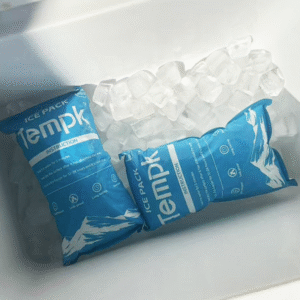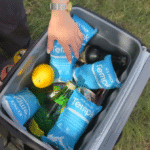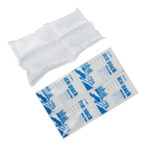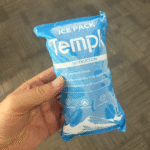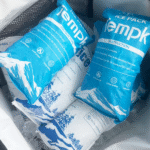Trockeneis-Packblätter vs. Trockeneissteine: Welches sollten Sie für den Versand wählen??
Der Versand temperaturempfindlicher Produkte erfordert eine sorgfältige Abwägung der Kühlmethoden, insbesondere bei der Verwendung von Trockeneis. Die wichtigsten Unterschiede zwischen verstehen Trockeneis-Packblätter Und Trockeneissteine ist von entscheidender Bedeutung für Unternehmen, die auf diese Produkte angewiesen sind, um die Unversehrtheit ihrer Waren während des Transports zu wahren. Dieser Artikel befasst sich mit den Merkmalen, Vorteile, und Herausforderungen jeder Kühllösung, Wir helfen Ihnen bei der Auswahl des besten Anbieters basierend auf Ihren spezifischen Versandanforderungen.
-
Verstehen Sie die wichtigsten Unterschiede zwischen Trockeneis-Packplatten und Trockeneissteinen, einschließlich ihrer Kühleffizienz und Temperaturhaltung.
-
Lernen Sie Best Practices kennen zum Verpacken und Versenden mit Trockeneis, folgende 2025 Vorschriften und Richtlinien.
-
Treffen Sie fundierte Entscheidungen Welche Trockeneislösung zu Ihrer Branche passt?, ob Sie Lebensmittel versenden, Arzneimittel, oder Laborproben.
Was sind Trockeneis-Packblätter und Trockeneissteine??
Trockeneis gibt es in zwei Hauptformen: Trockeneis-Packblätter Und Trockeneissteine. Beide sind darauf ausgelegt, niedrige Temperaturen aufrechtzuerhalten, Sie bieten jedoch je nach Art der Sendung unterschiedliche Vorteile.
Trockeneisbeutelblätter
Trockeneisbeutelblätter sind flexibel, dünne Schichten Trockeneis, die häufig vorkommen gelbasiert. Diese Laken sind ideal für kleinere, platzsparende Sendungen, die eine kontrollierte Kühlung, aber keine Gefriertemperaturen erfordern. Diese werden häufig für Lebensmittel verwendet, Arzneimittel, und medizinische Geräte Das muss dazwischen bleiben 2°C und 8°C.
Trockeneissteine
Auf der anderen Seite, Trockeneissteine sind feste Kohlendioxidblöcke. Sie sublimieren langsamer und behalten eine gleichmäßige Konsistenz bei, extrem niedrige Temperatur von -78.5°C. Diese sind Perfekt für Langzeitsendungen oder Gegenstände, die erforderlich sind tiefgefrieren, wie zum Beispiel Tiefkühlkost, Impfungen, und Biologika.
Vorteile von Trockeneis:
1. Effiziente Kühlung
Trockeneis absorbiert Wärme und sorgt für einen stabilen Zustand, kalte Umgebung. Ob in Blatt- oder Blockform, Es ist darauf ausgelegt Konservieren temperaturempfindlicher Güter Während des Transits.
2. Keine flüssigen Rückstände
Im Gegensatz zu traditionellem Eis, Trockeneis schmilzt nicht in Wasser. Das heißt, es gibt kein Durcheinander, Dies macht es zu einer bevorzugten Option für den Versand von Artikeln wie Fleisch, Meeresfrüchte, und Pharmazeutika.
3. Kostengünstig
Während Trockeneis auf den ersten Blick teurer erscheinen mag, Seine Fähigkeit, die Temperatur über lange Zeiträume aufrechtzuerhalten, kommt Unternehmen zugute Vermeiden Sie kostspieligen Produktverderb.
Warum sollten Sie sich für Trockeneissteine oder Packplatten entscheiden??
Für lange Sendungen: Trockeneissteine
Trockeneisziegel Angebot längere Kühldauer aufgrund ihrer langsameren Sublimationsrate. Sie sind ideal für Langstreckenversand, besonders wenn gefrorene Produkte müssen bis zu konstant niedrigen Temperaturen gelagert werden 5 Tage.
-
Temperaturbereich: –78,5 ° C.
-
Kühldauer: 72–120 Stunden
-
Anwendungen: Impfungen, Biologika, gefrorenes Essen
Für kürzer, Weltraumsensible Sendungen: Trockeneisbeutelblätter
Trockeneis Packblätter sind oft flexibler und kostengünstig. Sie sind perfekt für kleinere Sendungen oder diejenigen, die es benötigen gekühlt Temperaturen ohne den Gefrierpunkt zu erreichen.
-
Temperaturbereich: 2° C bis 8 ° C.
-
Kühldauer: 24–48 Stunden
-
Anwendungen: Pharmazeutika, frisches Essen, Kosmetika
Ein direkter Vergleich
| Kühllösung | Temperaturbereich | Kühldauer | Anwendungsfall |
|---|---|---|---|
| Trockeneisbeutelblätter (Gel) | 2° C bis 8 ° C. | 24–48 Stunden | Pharmazeutika, gekühltes Essen, Mahlzeiten |
| Trockeneissteine (Solid Co₂) | –78,5 ° C. | 72–120 Stunden | Gefrorenes Essen, Biologika, Impfungen |
Was für Ihre Sendung besser ist?
Zwischen Trockeneis-Packblätter Und Trockeneissteine hängt von mehreren Faktoren ab:
-
Versanddauer: Für längere Sendungen, Trockeneissteine sind die bessere Option. Sie sorgen für eine längere Kühlung, Damit eignen sie sich perfekt für mehrtägige Sendungen.
-
Größe der Sendung: Trockeneis-Packplatten sind ideal für Kompakte Sendungen wo Platz ein Problem ist.
-
Budget: Trockeneis-Packplatten sind mehr kostengünstig im Vergleich zu Ziegeln, was sie zu einer guten Wahl macht kleiner, weniger zeitkritische Sendungen.
Best Practices für einen sicheren und effizienten Trockeneisversand
Beim Versand mit Trockeneis sind die richtige Verpackung und Handhabung von entscheidender Bedeutung. Hier sind einige wichtige Best Practices, um sicherzustellen, dass Ihr Trockeneis optimal funktioniert:
1. Verpackungsrichtlinien
-
Verwenden Sie isolierte Behälter: Packen Sie immer Trockeneis ein gut isolierte Boxen um die Wärmeübertragung zu reduzieren und die Abkühlung zu verlängern.
-
Belüftung sicherstellen: Trockeneis unterschwellt zu Kohlendioxidgas, was dazu führen kann Druckaufbau wenn es in einem luftdichten Behälter eingeschlossen ist. Lassen Sie die Entlüftungsöffnungen immer offen oder verwenden Sie eine belüftete Verpackung, damit das Gas sicher entweichen kann.
2. Kennzeichnung und Dokumentation
-
Richtige Gefahrenkennzeichnung: Trockeneis wird als klassifiziert als Gefahrgut durch die UNO. Verwenden Sie die richtige Kennzeichnung, einschließlich „Kohlendioxid, Solid“-Label und UN1845-Nummer.
-
Versandpapiere: Stellen Sie sicher, dass die Versanddokumente die Trockeneismenge genau angeben und die entsprechenden Handhabungsanweisungen enthalten.
3. Gewichts- und Mengenrichtlinien
-
Versandbeschränkungen: Die maximale Menge an Trockeneis pro Sendung beträgt im Allgemeinen 5.5 Pfund (2.5 kg), Bei größeren Sendungen ist zusätzlicher Papierkram erforderlich.
-
Berechnen Sie den Bedarf an Trockeneis: Für kurzfristige Sendungen, Planen Sie die Verwendung 0.5× das Produktgewicht in Trockeneis. Für längere Sendungen, den Betrag erhöhen basierend auf der Abkühldauer.
2025 Trends bei Trockeneisschifffahrt
Wie wir hinschauen 2025, Die Trockeneisschifffahrtsindustrie entwickelt sich weiter, um der steigenden Nachfrage gerecht zu werden Nachhaltigkeit Und Technologieintegration:
Nachhaltige Verpackung
Viele Unternehmen sind es Investition in wiederverwendbare Trockeneisbeutel Und Umweltfreundliche Verpackung Lösungen zur Reduzierung ihres CO2-Fußabdrucks. Dieser Trend steht im Einklang mit dem wachsenden Fokus auf Umweltverantwortung.
Intelligente Sensoren für Echtzeitüberwachung
Fortschritte in intelligente Verpackungen Echtzeit ermöglichen Temperaturüberwachung, Sicherstellen, dass temperaturempfindliche Waren während des Transports im gewünschten Bereich bleiben.
Geschlossene Recyclingsysteme
Einige Unternehmen haben es übernommen Trockeneis-Recyclingsysteme mit geschlossenem Kreislauf, Dadurch kann Trockeneis mehrfach wiederverwendet werden, Abfall reduzieren und Kosten senken.
Häufig gestellte Fragen
Q1: Wie berechne ich die Trockeneismenge für meine Sendung??
Für 24-Stundenversand, verwenden 0.5× das Produktgewicht in Trockeneis. Für 48-Stundenversand, Passen Sie das Gewicht des Trockeneises an das Produktgewicht an.
Q2: Kann Trockeneis für internationale Sendungen verwendet werden??
Ja, aber stellen Sie sicher, dass Sie diese einhalten internationale Vorschriften und stellen Sie eine ordnungsgemäße Dokumentation für jedes Land sicher.
Q3: Wie lange kann Trockeneis eine kalte Temperatur aufrechterhalten??
Trockeneissteine können bis zu extrem niedrige Temperaturen aufrechterhalten 120 Std., während Trockeneisbeutel halten können 24-48 Std. abhängig von den Bedingungen.
Abschluss: Auswahl der richtigen Trockeneislösung
Auswahl der geeigneten Trockeneislösung –Trockeneis-Packblätter oder Trockeneissteine– hängt von den Temperaturanforderungen Ihres Produkts ab, Versanddauer, und Budget. Indem Sie die in diesem Artikel beschriebenen Best Practices befolgen und über die neuesten Trends im Trockeneisversand informiert bleiben, Sie können den sicheren und effizienten Transport Ihrer temperaturempfindlichen Produkte gewährleisten.
Nächste Schritte für Ihr Unternehmen:
-
Überprüfen Sie Ihre Versandprotokolle um herauszufinden, welche Trockeneislösung Ihren Anforderungen entspricht.
-
Stellen Sie die Einhaltung sicher 2025 Vorschriften bezüglich der Verpackung, Beschriftung, und Dokumentation.
-
Arbeiten Sie mit Logistikexperten zusammen um Ihre Kühlkette zu optimieren und das Verderbrisiko zu reduzieren.
Über Tempk
Tempk ist auf die Bereitstellung spezialisiert Modernste Kühlkettenlösungen maßgeschneidert auf Ihre Versandbedürfnisse. Von Trockeneisprodukten bis hin zu fortschrittlichen Logistiksystemen, Wir sorgen dafür, dass Ihre temperaturempfindlichen Güter sicher und effizient ihr Ziel erreichen. Kontaktieren Sie uns noch heute für eine Beratung zur Optimierung Ihrer Kühlkettenlösungen.






